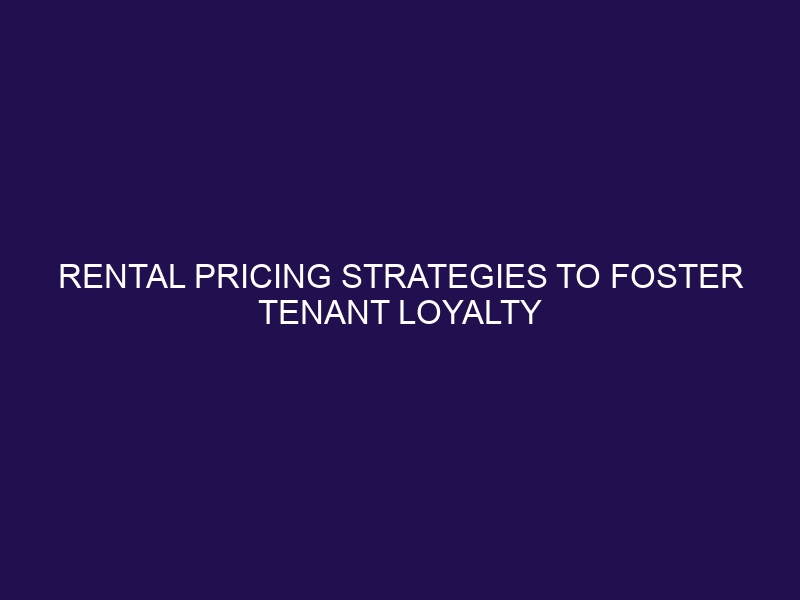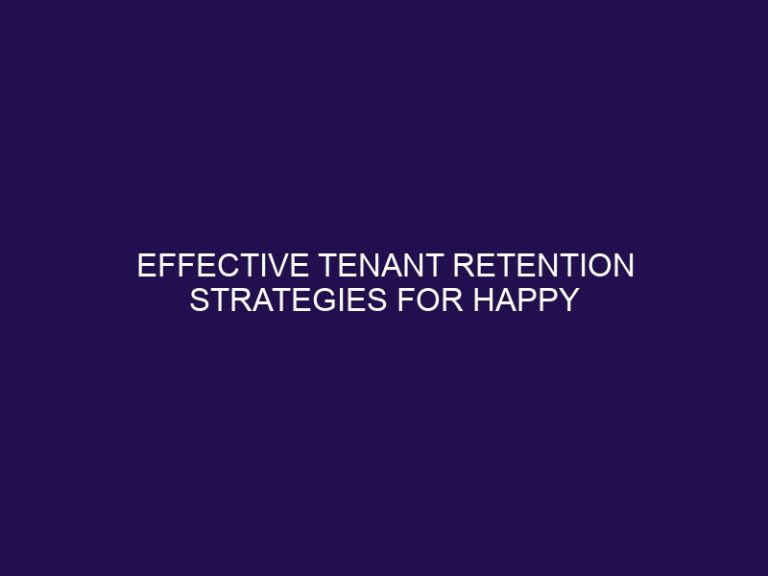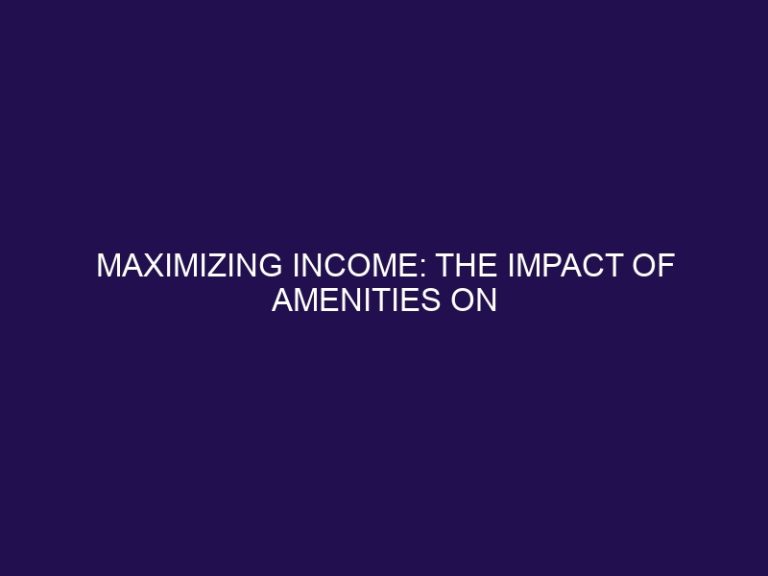Rental Pricing Strategies to Foster Tenant Loyalty
Tenant loyalty is crucial for rental properties as it not only ensures a steady stream of income but also reduces vacancies and turnover costs. One effective way to foster tenant loyalty is through strategic rental pricing. By implementing the right pricing strategy, landlords can attract and retain long-term, satisfied tenants.
There are different types of rental pricing strategies, including:
- Fixed rent pricing
- Variable pricing
- Seasonal pricing
- Promotional pricing
Each strategy has its own advantages and can be suitable for different types of rental properties. For instance, fixed rent pricing offers stability for both the landlord and tenant, while seasonal pricing allows for adjustments to rental rates based on peak and off-peak periods.
Rental pricing strategies can play a significant role in fostering tenant loyalty in the following ways:
- Offering competitive pricing ensures that tenants are getting a good value for their money, which can lead to higher satisfaction and loyalty.
- Providing flexible lease options, such as month-to-month or short-term leases, caters to the needs of different types of tenants and can increase their loyalty to the property.
- Offering discounts and incentives, such as referral bonuses or loyalty discounts, can encourage tenants to renew their lease and continue renting from the same property.
- Implementing a loyalty program can reward long-term tenants and make them feel valued, which can lead to increased loyalty and satisfaction.
When choosing a rental pricing strategy, landlords should consider several factors, including:
- Location and market demand: The rental rates should align with the rental market in the specific location, as well as the demand for rental properties in that area.
- Property features and amenities: The pricing should reflect the amenities and features offered by the property, such as location, size, and condition.
- Target audience and tenant preferences: Understanding the target audience and their preferences can help landlords tailor their pricing strategy to appeal to their target market.
- Competitor analysis: Conducting a competitor analysis can help landlords understand the rental rates of similar properties in the area and adjust accordingly.
In conclusion, implementing an effective rental pricing strategy can play a significant role in fostering tenant loyalty and creating a positive experience for tenants. Landlords should carefully consider the factors mentioned above and choose the right pricing strategy to ensure tenant satisfaction and long-term loyalty.
Why is Tenant Loyalty Important for Rental Properties?
Tenant loyalty is incredibly important for rental properties as it not only guarantees consistent occupancy, but also helps to minimize turnover costs and promotes a positive community atmosphere. To encourage loyalty among tenants, landlords can offer incentives for long-term leases, prioritize timely maintenance, and cultivate a responsive and respectful relationship with their tenants.
What are the Different Types of Rental Pricing Strategies?
As a landlord or property manager, choosing the right rental pricing strategy can greatly influence tenant loyalty and satisfaction. There are various types of rental pricing strategies to consider, each with its own unique benefits and drawbacks. In this section, we will explore the different types of rental pricing strategies, including fixed rent pricing, variable rent pricing, seasonal rent pricing, and promotional rent pricing. By understanding these strategies, you can make an informed decision on which one best suits your rental property and tenants’ needs.
1. Fixed Rent Pricing
- Set a specific monthly rental amount for the property.
- Ensure that the fixed rent pricing is competitive within the local rental market.
- Communicate clearly with tenants regarding any potential rent adjustments.
- Provide a written lease agreement detailing the terms and conditions of the fixed rent pricing.
2. Variable Rent Pricing
- Set Base Rent: Determine a standard rent rate for a specific period.
- Factor in Variables: Adjust rent based on factors like market demand, property condition, or tenant turnover.
- Review Regularly: Periodically assess variables influencing the rent to ensure it reflects market conditions.
- Communicate Clearly: Clearly outline the variables affecting rent in the lease agreement to avoid misunderstandings.
Did you know? Variable Rent Pricing can help landlords adapt to changing market conditions, ensuring competitiveness and tenant satisfaction.
3. Seasonal Rent Pricing
- Identify peak rental seasons based on local demand.
- Adjust rental rates to reflect increased demand during the seasonal rent pricing.
- Offer special promotions or discounts during off-peak periods.
- Communicate seasonal pricing changes clearly to tenants.
4. Promotional Rent Pricing
- Create enticing limited-time offers for new tenants, including promotional rent pricing.
- Implement referral programs rewarding current tenants for bringing in new renters.
- Provide upgrade options or additional services at a discounted rate.
- Host exclusive events or activities for tenants.
To attract and retain tenants, consider offering special deals and experiences that add value to their rental experience.
How Can Rental Pricing Strategies Foster Tenant Loyalty?
As a landlord or property manager, maintaining tenant loyalty is crucial for a successful and profitable rental business. One effective way to foster tenant loyalty is through strategic rental pricing. In this section, we will discuss various rental pricing strategies that can help retain tenants and create a positive rental experience for both parties. From offering competitive pricing to implementing a loyalty program, we’ll dive into the different tactics you can use to foster tenant loyalty.
1. Offering Competitive Pricing
- Conduct a comprehensive market analysis to establish fair and competitive pricing.
- Take into account the distinct features and amenities of the property when determining the rent to provide value.
- Compare the pricing with other similar properties in the vicinity to ensure competitiveness.
- Regularly adjust the pricing to align with current market trends and demand.
2. Providing Flexible Lease Options
- Offering flexible lease options such as month-to-month or short-term leases.
- Allowing tenants to transfer or sublet their lease.
- Providing lease renewal options with the flexibility to adjust rent.
- Implementing lease buyout options for tenants.
Suggestions: Prioritize the needs of tenants for long-term satisfaction and retention.
3. Offering Discounts and Incentives
- Create exclusive loyalty discounts for long-term tenants.
- Provide incentives such as free maintenance or upgrades for lease renewals.
- Offer referral rewards to current tenants for bringing in new renters.
- Implement seasonal promotions and rewards for timely rent payments.
Encouraging tenant loyalty through discounts and incentives can lead to long-term tenancy and positive word-of-mouth, fostering a thriving rental community.
4. Implementing a Loyalty Program
- Create a points-based system for rent discounts or exclusive amenities as part of our loyalty program.
- Offer referral rewards for tenant recommendations to further incentivize loyalty.
- Organize tenant appreciation events and personalized gestures to show our continued gratitude for our loyal tenants.
- Provide early lease renewal bonuses to encourage extended stays and reward loyalty.
What are the Factors to Consider when Choosing a Rental Pricing Strategy?
As a landlord or property manager, choosing the right rental pricing strategy is crucial for fostering tenant loyalty and maximizing profits. However, there are several factors to consider before deciding on a pricing strategy. In this section, we will discuss the key elements that should be taken into account, including location and market demand, property features and amenities, target audience and tenant preferences, and competitor analysis. By understanding these factors, you can make an informed decision on the best rental pricing strategy for your property.
1. Location and Market Demand
- Analyze location-specific rental demand trends and demographics.
- Assess nearby amenities, transport links, and job opportunities that affect demand.
- Research market rental rates and property occupancy levels in the area.
- Consider the potential for future growth or decline in the area.
2. Property Features and Amenities
When determining rental pricing strategies, the attractiveness of property features and amenities is a significant factor. For example, the inclusion of modern conveniences such as smart home systems, upscale appliances, or access to fitness centers can justify higher prices and encourage tenant loyalty. Furthermore, well-maintained outdoor spaces and security features enhance the desirability of the property.
3. Target Audience and Tenant Preferences
When devising rental pricing strategies, it is essential to take into account the 3. target audience and tenant preferences. By customizing pricing based on the demographics and preferences of tenants, it is possible to enhance their satisfaction and loyalty.
Thorough research is crucial in order to align pricing with the needs and desires of the target audience.
4. Competitor Analysis
- Identify Competitors: Conduct thorough research on rental properties in the area that are similar to yours.
- Analyze Pricing: Compare rental rates, incentives, and lease terms offered by your competitors to gain a better understanding of the market.
- Evaluate Amenities: Assess the features and services provided by rival properties to see how you can improve your own offerings.
- Understand Occupancy: Examine the occupancy rates and tenant retention of competing rentals to stay competitive in the market.
A property manager once increased tenant loyalty by providing personalized lease renewal gifts, strengthening their relationships with tenants.
Frequently Asked Questions
What are some effective rental pricing strategies to foster tenant loyalty?
There are several effective rental pricing strategies that property managers can use to foster tenant loyalty. Some of these strategies include offering free utilities, implementing dynamic pricing strategies, providing competitive amenities, and offering value-added services.
What are some examples of value-added services that can help attract and retain tenants?
Examples of value-added services that can help attract and retain tenants include grocery delivery, free Wi-Fi, landscaping services, and upgraded carpets or flooring. These services can create value for tenants and make them more likely to stay longer in the rental property.
How can property management software help in fostering tenant loyalty?
Property management software can be a useful tool in fostering tenant loyalty. It can help track tenant payment histories, manage maintenance and repair schedules, and send timely reminders for lease renewals and other important dates. This can improve communication channels and ensure that tenants feel valued and cared for.
What are some incentives that can be offered to tenants to encourage good behavior and ensure loyalty?
Monetary incentives, such as rent reductions or waived application fees, are commonly used to encourage good behavior and ensure tenant loyalty. Other incentives can include offering gift cards, free months of rent, or gym memberships as rewards for good behavior or outstanding tenant behavior.
Why is fostering a sense of community important for tenant retention rates?
Fostering a sense of community is important for tenant retention rates because it can make tenants feel more connected to their neighbors and the property. This can be done through organizing social events, creating common spaces, and promoting community involvement. A positive relationship with the local community can also contribute to a safe and desirable living experience for tenants.
How can regularly analyzing rental pricing help property managers attract and retain quality tenants?
Regularly analyzing rental pricing can help property managers attract and retain quality tenants by ensuring that rent rates are competitive in the market. It can also help identify potential issues, such as hidden charges, that may be driving away tenants. By staying on top of rental pricing, property managers can create a value proposition that attracts valuable long-term renters and maintains a sustainable operation for their property.







